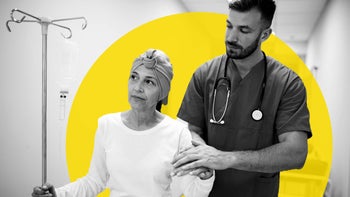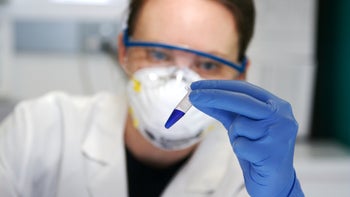
What Are the Pros and Cons of Gene Therapy?
Key takeaways:
Gene therapy is a cutting edge medical treatment that has pros and cons.
Gene therapy can be life-saving for some people with specific medical conditions, but it’s expensive and can cause side effects.
The development of gene therapy is highly regulated by the FDA and National Institute of Health.

Have you ever wondered what makes you, well, you? Your eye color, the texture of your hair, and even aspects of your personality are all determined by your genes. You can think of genes as the body’s “instruction manual.” Your genes tell your body how to work. They live in almost every cell in your body, and they’re made up of a chemical called DNA. You’re the only person on the planet who has your exact DNA (unless you’re an identical twin!)
Our genes play a big role in our overall health. Every unique gene has a DNA sequence that is considered “normal” for that particular gene. But, sometimes this DNA sequence is different than usual. This is called a gene variant. Sometimes these are inherited, which means they’re passed from parent to child. Other times, they’re caused by something in the environment, such as frequent sun exposure.
That’s where gene therapy comes in. Gene therapy gives us a way to modify our DNA. The goal is to return any abnormal DNA to normal conditions. This could mean replacing the faulty gene with a healthy copy. Or, it could mean making the faulty gene inactive. It also could mean an entirely new gene is introduced to the body to help treat the medical condition.
The first gene therapy study was conducted in 1990. Over three decades later, we’re still learning about its true potential in treating various medical conditions, including genetic disorders and cancer. A genetic disorder is a medical condition caused by DNA that is different from what is considered normal.
In this article, we’ll talk about the pros and cons of gene therapy.
How does gene therapy work?
Gene therapy is a type of treatment used to treat genetic disorders and other medical conditions. Gene therapy is considered a type of biologic treatment. They are called “biologics” because they come from living sources, not chemicals.
Read more like this
Explore these related articles, suggested for readers like you.
The goal of gene therapy is to change how existing genes in your body operate. There are three ways this can occur:
Gene inhibition: turning off the gene that is responsible for encouraging disease
Gene augmentation: adding a health copy of a gene to a cell where a faulty gene exists, so the healthy copy can override the negative effects caused by the faulty gene
Killing disease-causing cells: giving an unhealthy cell “instructions” (a set of new DNA) which causes the cell to die
Let’s talk about a couple examples of gene therapy so you can see how they work in real life.
Consider Luxturna (voretigene neparvovec), a type of gene therapy used to treat a type of inherited vision loss. Luxturna contains a healthy copy of the RPE65 gene, a gene that can lead to blindness if mutated. When Luxturna is injected in the eye, this healthy copy acts in place of the mutated RPE65 gene and restores vision loss. This is an example of gene augmentation.
Now consider Kymriah (tisagenlecleucel), a gene therapy used to treat acute lymphoblastic leukemia and certain types of non-Hodgkin’s lymphoma. Kymriah is made by taking a person’s own T cells (a type of white blood cell), and modifying them in a laboratory so they contain a specific protein. This protein, chimeric antigen receptor (CAR), attaches to the surface of cancer cells and destroys them to help clear cancer from the body. This is an example of killing disease-causing cells.
What are the pros and cons of gene therapy?
You’re probably noticing that gene therapy is pretty complicated, but exciting too. It has the potential to be life-changing for people with rare genetic diseases, cancer, and more. But like all medical treatments, there are positive and negative aspects to using gene therapy. It’s always important to weigh the risks and benefits of any medical treatment. Here, we’ll talk through some of the pros and cons of using gene therapy.
Pros
Provides options. Gene therapy can potentially cure someone of a disease, especially in instances where no other medications have worked.
Only has to be given one time. Existing gene therapies are given as a one-time dose. This is appealing compared to some other treatments that require multiple doses.
Long-lasting effects. Gene therapy has the potential to get rid of a person’s symptoms for life. Gene therapy can give many people a better quality of life.
Positive effects passed down through generations. If you remove a faulty gene from a parent, they won’t transfer this gene to their kids.
Rapidly-changing technology. Gene therapy is able to exist because of massive advances in technology over the past few decades. Since technology continues to advance, we can expect gene therapy to continue to improve. We can also expect more gene therapies to gain FDA approval.
Cons
Expensive. Gene therapy can be extremely pricey, making it inaccessible for some people. For example, Zolgensma, a gene therapy to treat spinal muscular atrophy, is the most expensive medication in the U.S. It costs $2.1 million for a course of treatment.
Experimental. Gene therapy is relatively new and there’s still a lot about it that we don’t know. Right now, there are no guarantees. Exactly how successful gene therapy will be is still uncertain.
Potentially dangerous. There’s some concern that if gene therapy reaches other cells in the body besides the faulty cell, it could have harmful effects. There’s also concern that reproductive cells could be changed without detection, and these could be passed on to people’s children.
Ethical issues. Some people have ethical issues with gene therapy. For example, some wonder who will decide what “good” and “bad” uses of gene therapy are? And will gene therapy make us less accepting of people who are different?
May cause infection. Some gene therapies use inactivated viruses to carry healthy genetic material into a faulty cell in the body. It’s possible that these viruses could infect the person receiving therapy.
How safe is gene therapy?
This answer is complicated. The process of developing gene therapy is long and highly monitored. From initial creation of the treatment to the research studies (clinical trials) that test it, teams of researchers assess whether the gene therapy is safe and effective. In the U.S., all gene therapy products are regulated by the FDA. Researchers who want to develop gene therapy and test it on people have to get permission first. And, the National Institute of Health (NIH) has guidelines for researchers who want to study gene therapy.
All this regulation of gene therapy makes it more likely that serious health risks are identified and prevented before a treatment becomes available to the public. But, this process isn’t foolproof. As with any medication, toxicity and side effects can still occur. The use of gene therapy is relatively new, so there may be unpredictable risks. And, we don’t know how long it takes to see side effects. Delayed side effects could occur, which requires people in clinical trials to be monitored for a long time.
Researchers have talked about the importance of sharing data on gene therapy studies. Sharing data helps us learn what has worked and what hasn’t in regards to gene therapies. It helps us progress more quickly towards developing more gene therapy products that could be lifesaving for many people.
Can gene therapy help me?
If you have a medical condition that can be treated by FDA-approved gene therapies, you might wonder if you should consider it. Usually, gene therapies aren’t first-choice options. Most people using gene therapies have tried other medical therapies first, but they didn’t work. If this is the case for you, talk to your healthcare provider to learn more about gene therapy and whether it’s a safe option for you.
The bottom line
Gene therapy is a type of medical treatment that gives us a way to modify our DNA. It’s an exciting, yet complicated, treatment option that has the potential to be life-changing for people with rare genetic diseases, cancer, and more. But like all medical treatments, there are pros and cons to using gene therapy. It’s important to familiarize yourself with the risks of gene therapy if you think you may need it to treat your medical condition. Talk to your healthcare provider to learn more about gene therapy risks and benefits, and whether it's a safe option for you.
Why trust our experts?


References
American Society of Human Genomics (2019). Building blocks of the genetic code.
American Society of Gene + Cell Therapy. (2022). Gene therapy basics.
Bessis, N., et al. (2004). Immune responses to gene therapy vectors: Influence on vector function and effector mechanisms. Gene Therapy.
European Medicines Agency. (2020). Kymriah.
Food and Drug Administration. (2018). FDA approves novel gene therapy to treat patients with a rare form of inherited vision loss.
Food and Drug Administration. (2018). What is gene therapy?
Food and Drug Administration. (2021). Cellular & gene therapy products.
Goswami, R., et al. (2019). Gene therapy leaves a vicious cycle. Frontiers in Oncology.
MedlinePlus. (2021). Is gene therapy safe?
MedlinePlus. (2021). What are the ethical issues surrounding gene therapy?
MedlinePlus. (2021). What is a gene variant and how do variants occur?
Miller School of Medicine. (n.d.). Are identical twins 100% genetically identical? University of Miami Health System.
Mitha, F. (2020). The return of gene therapy. Labiotech.
Mullis, E., et al. (n.d.). Genes made easy. Genes and Health.
National Human Genome Research Institute. (n.d.). Genetic disorders.
National Human Genome Research Institute. (n.d.). Gene therapy.
Nature Medicine. (2021). Gene therapy needs a long-term approach. Nature Medicine.
Sinclair, A., et al. (2018) Gene therapy: An overview of approved and pipeline technologies. Canadian Agency for Drugs and Technologies in Health.
Tabak, L.A. (2019). Final action under the NIH guidelines for research involving recombinant or synthetic nucleic acid molecules (NIH guidelines). Federal Register.
Tamura, R., et al. (2020). Historic overview of genetic engineering technologies for human gene therapy. Neurologia Medico-chirurgica (Tokyo).
University of Missouri School of Medicine. (n.d.). Gene therapy and genetic engineering.
YourGenome. (2021). What is gene therapy?
















